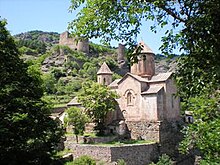| no flag on Wikidata: | |
| სამცხე-ჯავახეთი (Samtskhe-Javakheti) | |
| Capital | Akhaltsikhe |
|---|---|
| Residents | 160.000 |
| other value for residents on Wikidata: 155903 | |
| surface | 6,400 km² |
| other value for area on Wikidata: 6413 | |
| website | samtskhe-javakheti.gov.ge/ |
| no tourist info on Wikidata: | |
Samtskhe Javakheti(Georgian: სამცხე-ჯავახეთი, Samtskhe-Javakheti) is an administrative region (Mchare) in South Georgia. The historical name of the region is "Mes'cheti". The capital of the region is Akhaltsikhe.
Regions

Samtskhe-Javakheti is located in the small Caucasus and is roughly divided into two large areas: the valley of the Kura (Mtkvari) and the mountains of the Trialeti chain including the high plateau on Lake Paravani.
places

Capital is Akhaltsikhe. Other district capitals are:
Other goals
- Abastumani (Climatic health resort and historical observatory)
- The cave monastery of Vardsia
- Winter sports resort Bakuriani
- Poka
background
The south of this region is very strongly Armenian, while the north is populated by ethnic Georgians. Historically, the southern part of this region was part of the Georgian Kingdom and accordingly inhabited by Georgians. When the Ottomans found this province in the 16th century. conquered, they settled there Turks, who at some point made up the majority. The Turkish-speaking people of the Turk-Mesheth arose from the Georgian-Turkish ethnic mix. Towards the end of the 19th century. and especially after the genocide against the Armenians by the Ottomans, Tsarist Russia decided to settle Armenian refugees from Turkey in the south of the above-mentioned province. The Meshes themselves were deported in 1944, so that the Armenians made up the majority. Until 2007, Russia had military bases in the south, as Russians are seen by Armenians as natural allies against Turks. Under President Saakashvili, efforts to integrate Javakhetia were intensified. The Baku - Tbilisi - Kars railway line and a pipeline run through Javakhetia, which also gives the region strategic importance.
language

In addition to Georgian, Armenian is predominantly spoken in some areas, especially in the districts of Akhalkalaki and Ninozminda. In the Armenian regions, Georgian is hardly understood at all. The common foreign language is Russian. English is almost not widespread.
getting there
- Of Tbilisi there are two trains a day to Borjomi. The rest of the railway line over Akhaltsikhe after Wale is no longer open to passenger traffic.
- From Tbilisi you can also take marshrutkas (minibuses) directly to most of the larger towns in the region.
- The railway line from Tbilisi over Zalka to Ninozminda and Akhalkalaki is currently not in operation either, it will be added to the new Tbilisi railway line to be built in the coming years.Kars integrated. It is quite possible that in a few years there will be passenger trains from the Turkey will give to Georgia.
- By car: from Tbilisi either over Gori and Chashuri to Borjomi and from there on to Akhaltsikhe. Or over the new, very well developed regional road Manglisi-Zalka and Lake Paravani to Ninozminda.
- The road over the Goderdsi pass between Batumi and Akhaltsikhe is in poor condition, unpaved with deep erosion. In winter (October-April) this route is impassable due to snow conditions. An off-road vehicle is recommended, at least a vehicle with greater ground clearance is necessary.
- Of the Turkey there are two border crossings (Posof-Whales and Karzachi Akhalkalaki). Of Armenia from there is a border crossing at Ninozminda (Zhdanowi-Bawra).
- There is no airport in Samtskhe Javakheti. The nearest airports are in Tbilisi, or in Kars (Turkey) or Gyumri (Armenia).
- Arriving from Turkey by bus: There are buses or dolmus / marshrutkas from Artvin and Kars to Akhaltsikhe. Alternatively, you can also take a dolmus to the border at Posof, cross the border on foot and continue on a marshrutka. This saves you a lot of money, but the journey is a little less comfortable.
mobility

Marshrutkas (minibuses) and own car. The main connecting routes are well developed, and an off-road vehicle is recommended for secondary roads - especially in the mountains Borjomi and Bakuriani runs a narrow-gauge railway that "Kukuschka", which take two pairs of trains a day for about 35 km approx. 2 1/2 hours, but the journey is breathtakingly beautiful.
Tourist Attractions


- Okami earth houses
- Borjomi-Kharagauli National Park
- Sapara. 13th century, many frescoes and icons.
- Green monastery
- Poka monastery complex
- Tabazkuri lake
activities

- Bakuriani: Skiing and cross-country skiing in winter, hiking in summer.
- Rafting and canoeing on Mtkvari
- Hiking in Borjomi-Kharagauli National Park
kitchen

- Borjomi mineral water is world famous, especially in the former Eastern Bloc countries it enjoys cult status. It can be drunk directly from the source in the Kurpark Borschomi, but the taste, due to the high iron and mineral content, takes getting used to.
nightlife
security
No major uncertainties compared to the rest of the country.
climate
Continental, hot dry summers, cold winters. In the mountains it can get very cold even in summer.
literature
The Swiss development aid co-funded the creation of a comprehensive guide to the region (in English and Georgian), the can be downloaded free of charge as a PDF.
Web links
http://samtskhe-javakheti.gov.ge/ (ka) - Official website of Samtskhe-Javakheti
